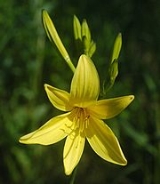
Hemerocallis lilioasphodelus
Encyclopedia
Hemerocallis lilioasphodelus, (syn. Hemerocallis flava, Lemon Day-lily Lemon Lily, Yellow Day-lily) is a plant of the genus Hemerocallis. It is found across China
, in Europe in N.E. Italy and Slovenia and is one of the first daylilies used for breeding.
Hemerocallis lilioasphodelus grows in big spreading clumps and its leaves grow to 75 cm (30 in) long. It has lemon-yellow flowers with a sweet scent in a cluster of 3 to 9 flowers.
and Japanese cuisine
. They are sold (fresh or dried) in Asian markets
as gum jum or golden needles (金针 in Chinese
; pinyin: jīnzhēn) or yellow flower vegetables (黃花菜 in Chinese
; pinyin: huánghuācài). They are used in hot and sour soup
, daylily soup (金針花湯), Buddha's delight
, and moo shu pork
. The young green leaves and the tuber
s of Hemerocallis lilioasphodelus are also edible. The plant has also been used for medicinal purposes.
China
Chinese civilization may refer to:* China for more general discussion of the country.* Chinese culture* Greater China, the transnational community of ethnic Chinese.* History of China* Sinosphere, the area historically affected by Chinese culture...
, in Europe in N.E. Italy and Slovenia and is one of the first daylilies used for breeding.
Hemerocallis lilioasphodelus grows in big spreading clumps and its leaves grow to 75 cm (30 in) long. It has lemon-yellow flowers with a sweet scent in a cluster of 3 to 9 flowers.
Culinary use
The flowers of some daylillies, including Hemerocallis lilioasphodelus are edible and are used in Chinese cuisineChinese cuisine
Chinese cuisine is any of several styles originating in the regions of China, some of which have become highly popular in other parts of the world – from Asia to the Americas, Australia, Western Europe and Southern Africa...
and Japanese cuisine
Japanese cuisine
Japanese cuisine has developed over the centuries as a result of many political and social changes throughout Japan. The cuisine eventually changed with the advent of the Medieval age which ushered in a shedding of elitism with the age of shogun rule...
. They are sold (fresh or dried) in Asian markets
Asian supermarket
An Asian supermarket, sometimes called an "Oriental supermarket", is a grocery store in non-Asian countries that stocks items imported from the many countries in East and Southeast Asia. They carry items and ingredients generally well-suited for Asian cuisines and not found in most Western...
as gum jum or golden needles (金针 in Chinese
Chinese language
The Chinese language is a language or language family consisting of varieties which are mutually intelligible to varying degrees. Originally the indigenous languages spoken by the Han Chinese in China, it forms one of the branches of Sino-Tibetan family of languages...
; pinyin: jīnzhēn) or yellow flower vegetables (黃花菜 in Chinese
Chinese language
The Chinese language is a language or language family consisting of varieties which are mutually intelligible to varying degrees. Originally the indigenous languages spoken by the Han Chinese in China, it forms one of the branches of Sino-Tibetan family of languages...
; pinyin: huánghuācài). They are used in hot and sour soup
Hot and sour soup
Hot and sour soup can refer to soups from several Asian culinary traditions. In all cases the soup contains ingredients to make it both spicy and sour.-United States:Soup preparation may use chicken or pork broth, or may be meat-free...
, daylily soup (金針花湯), Buddha's delight
Buddha's delight
Buddha's delight, often transliterated as Luóhàn zhāi, lo han jai, or lo hon jai, is a vegetarian dish well known in Chinese and Buddhist cuisine...
, and moo shu pork
Moo shu pork
Moo shu pork is a dish of northern Chinese origin, possibly originally from Shandong...
. The young green leaves and the tuber
Tuber
Tubers are various types of modified plant structures that are enlarged to store nutrients. They are used by plants to survive the winter or dry months and provide energy and nutrients for regrowth during the next growing season and they are a means of asexual reproduction...
s of Hemerocallis lilioasphodelus are also edible. The plant has also been used for medicinal purposes.

